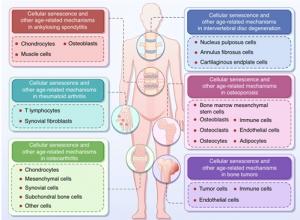The Aging Blueprint: Understanding the Cellular Mechanisms of Skeletal Aging
A new study maps how aging cells contribute to bone loss and degeneration, offering fresh insights into treating skeletal diseases
CHINA, August 19, 2025 /EINPresswire.com/ -- As bones weaken with age, the culprits may be the aging cells within. A new review uncovers how cellular changes—like senescence, inflammation, and loss of regenerative capacity—disrupt the delicate balance of bone formation and breakdown. By mapping these age-related mechanisms across multiple skeletal diseases, the study offers a clearer picture of how bones decline over time, and where potential therapies might intervene to slow or even reverse the process.Life expectancy is increasing globally, and along with it, skeletal diseases like osteoporosis, osteoarthritis, and spinal disc degeneration are becoming major causes of disability and poor quality of life. These conditions affect millions and lead to chronic pain, falls, fractures, immobility, and dependence. In older adults, even a minor fracture can result in hospitalization or permanent loss of independence. These disorders were long thought to be the result of “wear and tear”—gradual breakdown due to physical stress or bone loss over time. But growing research suggests that the true cause lies deeper.
Hidden within bone, cartilage, and connective tissue are aging cells that quietly lose function, disrupt the surrounding environments, and weaken the entire skeletal system from inside out. Despite this emerging understanding, there hasn’t been a clear explanation of how aging at the cellular level contributes to skeletal decline. Existing studies often focused on specific diseases or isolated cell types, leaving gaps in the bigger picture.
A new literature review, published online in the journal Bone Research on July 07, 2025, addresses this by bringing together findings from across cell biology, immunology, and aging science. The study was led by Dr. Hao Chen, Dr. Sihan Hu, and Dr. Ke Li from the Institute of Translational Medicine, Medical College, Yangzhou University, China. Together, the team outlines how cellular changes—especially senescence, inflammation, and stem cell exhaustion—can alter the balance of bone renewal and repair, driving disease across the skeleton.
Among the key cellular changes discussed in the review, cellular senescence—a state in which damaged cells stop dividing but don’t die—stands out as a major driver of skeletal decline. These cells remain in the body and release a harmful mix of molecules known as the senescence-associated secretory phenotype (SASP), which can trigger inflammation, break down nearby tissues, and even spread aging signals to neighboring healthy cells. “Our bones are maintained through a constant process of breaking down and rebuilding,” explains Dr. Chen. “Senescent cells interrupt this cycle, leading to imbalances that cause bones to weaken or joints to break down.”
In the bone marrow, mesenchymal stem cells, which normally give rise to bone-forming cells, begin to favor fat production as they age. This reduces the availability of new bone cells and weakens the overall structure. Osteoblasts (bone forming cells) and osteoclasts (breaks bone tissue) also become less efficient and poorly coordinated, resulting in fragile, porous bones, prone to fractures. Senescence also affects the cartilage cells, or chondrocytes, which begin producing enzymes that degrade the supportive tissues in joints. This breakdown, combined with chronic inflammation from SASP factors, contributes to osteoarthritis—a major cause of pain and reduced mobility in aging adults. In the spine, cells in intervertebral discs lose their ability to handle pressure and regenerate, leading to disc degeneration and spinal problems.
“Senescent cells don’t just affect their own tissues,” says Dr. Chen. “They send signals that alter the behavior of nearby immune cells, blood vessels, and bone stem cells—changing how the whole environment functions.”
This review also connects cellular aging to conditions like rheumatoid arthritis and bone tumors, where senescence-related changes may either trigger abnormal immune responses or support tumor growth in the aged tissues. While the role of senescence sounds alarming, the findings open promising new paths for treatment.
This study also highlights the efforts to develop senolytics—drugs that selectively remove senescent cells—and compounds that suppress their harmful secretions. In animal studies, these approaches have led to improved bone strength and joint health. The researchers also explore other emerging strategies, including cell therapy to restore aged stem cells, genetic interventions to reverse or slow aging-related damage, and even vaccine-based approaches designed to help the immune system clear senescent cells. Though many of these are still experimental, they represent a growing shift toward treating the root causes of skeletal aging—not just its symptoms.
“This review helps clarify the link between cellular aging and skeletal disease,” says Dr. Chen. “By targeting these root causes, we may be able to go beyond symptom relief and actually prevent or delay the onset of bone disorders.”
The researchers emphasize that more research is needed, especially on how different cell types communicate during aging and how systemic factors—like immune changes or blood supply—interact with local skeletal cells.
Overall, this study offers a valuable framework for understanding how aging at the cellular level contributes to bone loss and degeneration. By bringing together findings across different cell types and skeletal conditions, it sheds light on the common cellular changes that drive these disorders. As research advances, these insights could guide the development of therapies aimed at preserving bone health and promoting healthier aging in the years to come.
***
Reference
Title of original paper: Cellular senescence and other age-related mechanisms in skeletal diseases
Journal: Bone Research
DOI: 10.1038/s41413-025-00448-7
Yini Bao
Bone Research, Editorial Office
+862885546461 ext.
email us here
Visit us on social media:
X
Legal Disclaimer:
EIN Presswire provides this news content "as is" without warranty of any kind. We do not accept any responsibility or liability for the accuracy, content, images, videos, licenses, completeness, legality, or reliability of the information contained in this article. If you have any complaints or copyright issues related to this article, kindly contact the author above.
Bath Garden Center Offers Community Event for Families Offering Farm Animal Education for All Ages
Palms Up Leadership by Rich C. Plumery Redefines Leadership for the Modern Workplace
Lounge Lizard Worldwide Unveils 2025 Guide to Identifying and Preventing Black Hat SEO Threats
Więcej ważnych informacji
 Jedynka Newserii
Jedynka Newserii

 Jedynka Newserii
Jedynka Newserii

Prawo

Kolejne polskie miasta chcą być przyjazne dzieciom. Planują stworzyć najmłodszym dobre warunki do rozwoju
Cztery miasta w Polsce posiadają tytuł Miasta Przyjaznego Dzieciom nadany przez UNICEF Polska. Dziewięć kolejnych miast czeka na certyfikację, a w ostatnich miesiącach do programu zgłosiło się kilka następnych. Na całym świecie inicjatywa została przyjęta już w ponad 4 tys. samorządów, a w Hiszpanii objęła połowę dziecięcej populacji miast. Program UNICEF-u ma na celu zachęcenie włodarzy do traktowania najmłodszych obywateli w sposób podmiotowy, respektowania ich praw i zaproszenia ich do współdecydowania o przyszłości.
Przemysł
W ciągu roku w Polsce ubyło 500 przedsiębiorstw odzieżowo-tekstylnych. Problemem są spadki zamówień z Europy Zachodniej i wzrost kosztów

Wartość rynku odzieżowego w Polsce wynosi 66,9 mld zł, z czego 10 mld zł to wartość krajowej produkcji – wynika z danych PIOT. Od czasu pandemii branża mierzy się z szeregiem wyzwań, wśród których najpoważniejsze to wzrost kosztów pracy i produkcji, przerwane łańcuchy dostaw i spadek zamówień – zarówno w kraju, jak i za granicą, a także wzrost nieuczciwej konkurencji na rynku, czyli głównie importu z Chin. Skala wyzwań sprawia, że w ubiegłym roku z rynku zniknęło 500 firm. Producenci odzieży apelują do rządu o wsparcie.
Handel
D. Obajtek: Orlen powinien być o 30–40 proc. większą spółką. Byłoby to z korzyścią dla konsumentów

Orlen jest największym polskim przedsiębiorstwem. Jego przychody ze sprzedaży w 2024 roku wyniosły blisko 295 mln zł, a rok wcześniej – ponad 372 mln – wynika z raportu Rzeczpospolitej „Lista 500”. W ubiegłorocznym rankingu Fortune 500 uwzględniającym największe korporacje znalazł się na 216. miejscu na świecie i 44. w Europie. Według Daniela Obajtka, europosła PiS-u i byłego prezesa Orlenu, spółka powinna jeszcze urosnąć, tym samym gwarantując konsumentom szereg korzyści, a także przyspieszać inwestycje m.in. w obszarze petrochemii i energetyki zero- oraz niskoemisyjnej.
Partner serwisu
Szkolenia

Akademia Newserii
Akademia Newserii to projekt, w ramach którego najlepsi polscy dziennikarze biznesowi, giełdowi oraz lifestylowi, a także szkoleniowcy z wieloletnim doświadczeniem dzielą się swoją wiedzą nt. pracy z mediami.









.gif)

 |
| |
| |
|